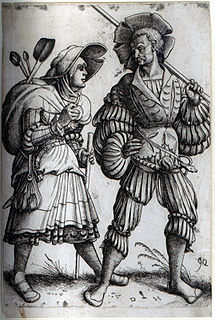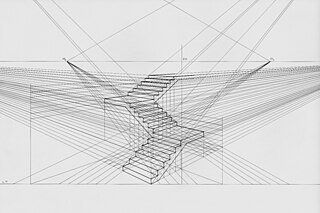
Victor Marie Hugo was a French poet, novelist, and dramatist of the Romantic movement. Hugo is considered to be one of the greatest and best-known French writers. Outside France, his most famous works are the novels Les Misérables, 1862, and The Hunchback of Notre-Dame, 1831. In France, Hugo is known primarily for his poetry collections, such as Les Contemplations and La Légende des siècles.
The focal length of an optical system is a measure of how strongly the system converges or diverges light. For an optical system in air, it is the distance over which initially collimated (parallel) rays are brought to a focus. A system with a shorter focal length has greater optical power than one with a long focal length; that is, it bends the rays more sharply, bringing them to a focus in a shorter distance.
In photography and cinematography, a normal lens is a lens that reproduces a field of view that appears "natural" to a human observer. In contrast, depth compression and expansion with shorter or longer focal lengths introduces noticeable, and sometimes disturbing, distortion.
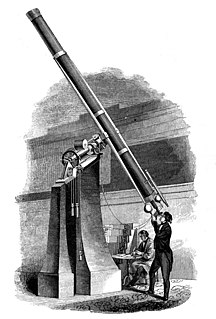
A refracting telescope is a type of optical telescope that uses a lens as its objective to form an image. The refracting telescope design was originally used in spy glasses and astronomical telescopes but is also used for long focus camera lenses. Although large refracting telescopes were very popular in the second half of the 19th century, for most research purposes the refracting telescope has been superseded by the reflecting telescope which allows larger apertures. A refractor's magnification is calculated by dividing the focal length of the objective lens by that of the eyepiece.
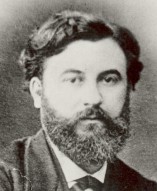
Charles-Émile Reynaud was a French inventor, responsible for the praxinoscope and the first projected animated films. His Pantomimes Lumineuses premiered on 28 October 1892 in Paris. His Théâtre Optique film system, patented in 1888, is also notable as the first known instance of film perforations being used. The performances predated Auguste and Louis Lumière's first paid public screening of the cinematographe on 26 December 1895, often seen as the birth of cinema.
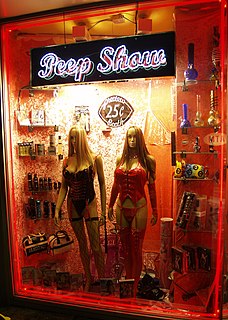
A peep show or peepshow is an exhibition of pictures, objects or people viewed through a small hole or magnifying glass. Though historically a peep show was a form of entertainment provided by wandering showmen, nowadays it more commonly refers to a presentation of a sex show or pornographic film which is viewed through a viewing slot. Historically the peep hole was intended to control the point of view to allow an illusion of depth perception, while showmen would later use it to charge for access to the view. For sex shows it also became a means to view material that would be objected to if freely displayed.
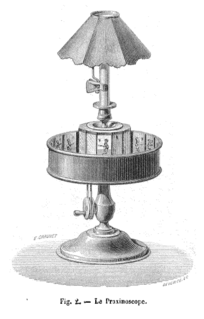
The praxinoscope was an animation device, the successor to the zoetrope. It was invented in France in 1877 by Charles-Émile Reynaud. Like the zoetrope, it used a strip of pictures placed around the inner surface of a spinning cylinder. The praxinoscope improved on the zoetrope by replacing its narrow viewing slits with an inner circle of mirrors, placed so that the reflections of the pictures appeared more or less stationary in position as the wheel turned. Someone looking in the mirrors would therefore see a rapid succession of images producing the illusion of motion, with a brighter and less distorted picture than the zoetrope offered.

Eugène Atget was a French flâneur and a pioneer of documentary photography, noted for his determination to document all of the architecture and street scenes of Paris before their disappearance to modernization. Most of his photographs were first published by Berenice Abbott after his death. An inspiration for the surrealists and other artists, his genius was only recognized by a handful of young artists in the last two years of his life, and he did not live to see the wide acclaim his work would eventually receive.
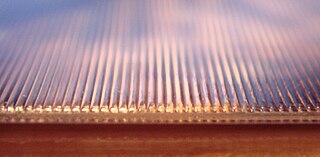
Lenticular printing is a technology in which lenticular lenses are used to produce printed images with an illusion of depth, or the ability to change or move as the image is viewed from different angles.
The Space Gamer was a magazine dedicated to the subject of science fiction and fantasy board games and role-playing games. It quickly grew in importance and was an important and influential magazine in its subject matter from the late 1970s through the mid-1980s. The magazine is no longer published, but the rights holders maintain a web presence using its final title Space Gamer/Fantasy Gamer.

Anamorphosis is a distorted projection or perspective requiring the viewer to occupy a specific vantage point, use special devices or both to view a recognizable image. Some of the media it is used in are painting, photography, sculpture and installation, toys, and film special effects. The word "anamorphosis" is derived from the Greek prefix ana‑, meaning "back" or "again", and the word morphe, meaning "shape" or "form". An optical anamorphism is the visualization of a mathematical operation called an affine transformation. The process of extreme anamorphosis has been used by artists to disguise caricatures, erotic and scatological scenes, and other furtive images from a casual viewer, while revealing an undistorted image to the knowledgeable spectator.
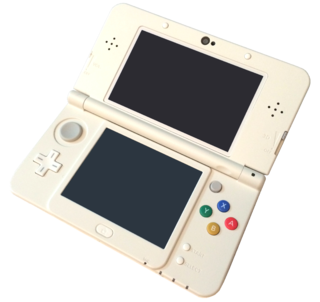
Autostereoscopy is any method of displaying stereoscopic images without the use of special headgear or glasses on the part of the viewer. Because headgear is not required, it is also called "glasses-free 3D" or "glassesless 3D". There are two broad approaches currently used to accommodate motion parallax and wider viewing angles: eye-tracking, and multiple views so that the display does not need to sense where the viewers' eyes are located.
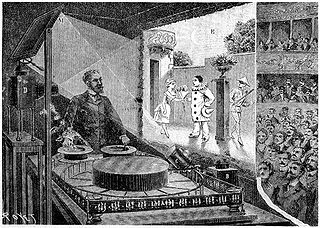
The Théâtre Optique was an animated moving picture system invented by Émile Reynaud and patented in 1888. From 28 October 1892 to March 1900 Reynaud gave over 12,800 shows to a total of over 500.000 visitors at the Musée Grévin in Paris. His Pantomimes Lumineuses series of animated films include Pauvre Pierrot and Autour d'une cabine. Reynaud's Théâtre Optique predated Auguste and Louis Lumière's first commercial, public screening of the cinematograph on 28 December 1895, which has long been seen as the birth of film.

Antoine Ignace Melling was a painter, architect and voyager who is counted among the “Levantine Artists”. He is famous for his vedute of Constantinople, a town where he lived for 18 years. He was imperial architect to Sultan Selim III and Hatice Sultan and later landscape painter to the Empress Josephine of France. His most influential work is published as Voyage pittoresque de Constantinople et des rives du Bosphore.
Jacques Chéreau was a portrait engraver, printmaker and publisher of optical prints in a neighborhood of printmakers at the Rue Saint-Jacques variously given on prints as "au Grand St. Remy," "au Coq," or "au dessus de la Fontaine St. Severin", in Paris, France.
Ken Gidge is an American state representative born on May 26, 1946, in Nashua, New Hampshire. Both his uncle, Lester Gidge, and his grandfather were inventors. Ken Gidge also became well known for both his inventions and his art.

In Japanese art, a megane-e is a print designed using graphical perspective techniques and viewed through a convex lens to produce a three-dimensional effect. The term derives from the French vue d'optique. The device used to view them was called an Oranda megane or nozoki megane, and the pictures were also known as karakuri-e.
